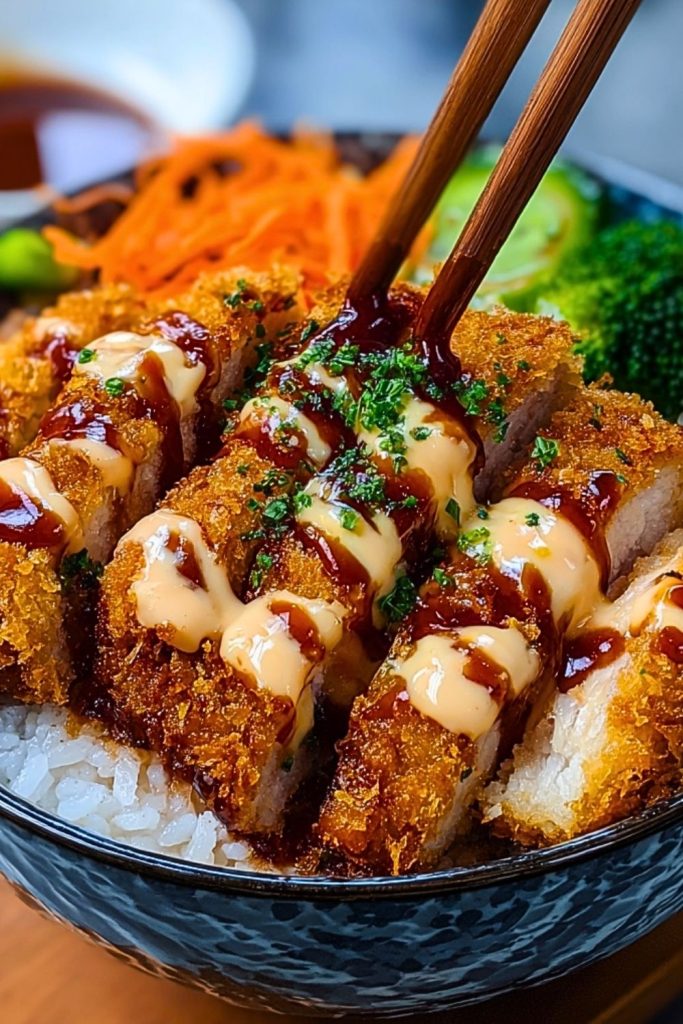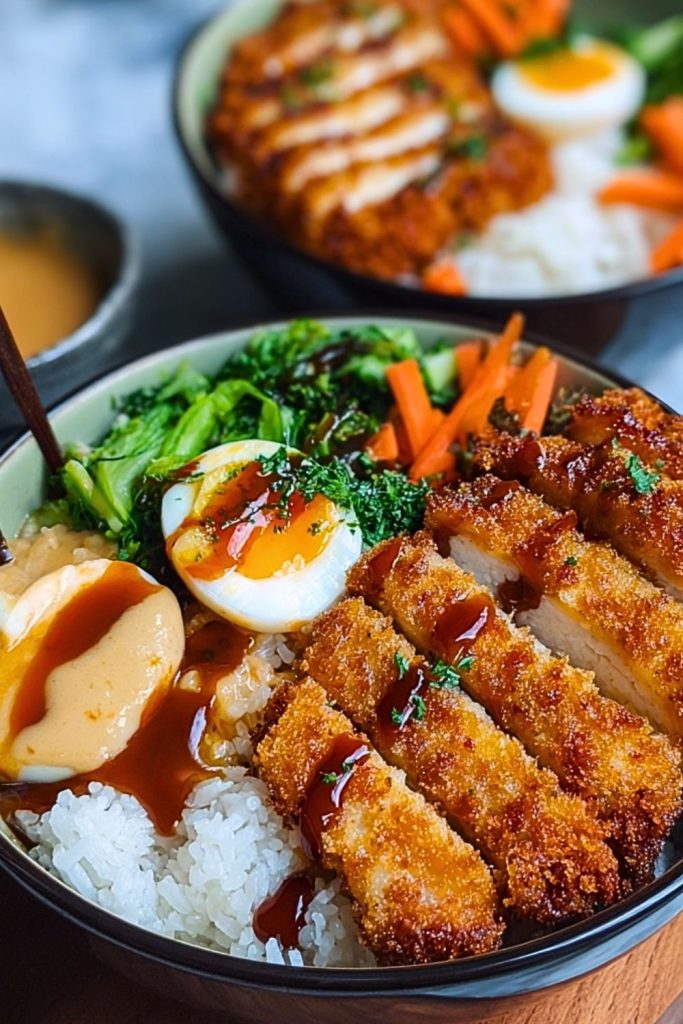When I first tried a Japanese katsu bowl, it instantly became one of my favorite comfort foods. The crispy, golden-brown breaded pork cutlet paired with a rich, flavorful tonkatsu sauce, served on top of a bed of fluffy white rice, is a simple yet indulgent meal that never fails to impress. The best part? It’s incredibly easy to make at home! This dish is not only filling but also packed with so many delicious flavors that it feels like a special treat even on a busy weekday.

I’ve spent some time perfecting this recipe and tweaking it to ensure that the flavors balance perfectly, so I can enjoy this meal anytime I want. Whether you’re a fan of Japanese cuisine or just in need of a comforting dinner idea, this katsu bowl with tonkatsu sauce is sure to hit the spot. Let’s dive in and create this satisfying meal together!
Why You’ll Love This Katsu Bowl
A Katsu Bowl is the perfect combination of crispy and tender, sweet and savory, making it incredibly satisfying in every bite. The breaded pork cutlet, fried to perfection, offers a satisfying crunch, while the tonkatsu sauce adds a rich, umami-packed flavor. With the soft, warm rice underneath, it’s a balanced dish that gives you comfort in the best possible way. The best part? It’s versatile—use chicken, pork, or even tofu for a vegetarian version!
Making this at home means you have total control over the ingredients, allowing you to adjust the flavors and textures to your liking. You can also make a big batch and enjoy leftovers the next day. Whether you’re new to Japanese food or a seasoned fan, this recipe is sure to be a hit in your kitchen.
What Kind of Pork Should I Use for Katsu?
When it comes to making a traditional Japanese katsu bowl, the key ingredient is the pork cutlet. The most commonly used cut for katsu is pork loin or pork tenderloin. These cuts are tender, lean, and cook quickly, making them ideal for breading and frying. If you prefer something fattier, pork belly can also work well, though it has a bit more richness.
When choosing your pork, it’s best to opt for boneless cuts that will cook evenly and be easy to slice after frying. Make sure to pound the pork to an even thickness so it cooks uniformly. This ensures that every bite is juicy and tender.
Options for Substitutions
If you’re looking to change things up or don’t eat pork, there are plenty of substitution options:
- Chicken Katsu: Instead of pork, you can use boneless, skinless chicken breasts or thighs. Chicken katsu is just as crispy and delicious, with a lighter texture.
- Vegetarian Katsu: For a vegetarian alternative, tofu works great. Firm tofu can be pressed to remove excess moisture, then breaded and fried just like the pork.
- Beef Katsu: For a bolder, richer flavor, thinly sliced beef (like sirloin) can also be used for your katsu bowl. Just be sure to cut it thin enough to cook quickly.
- Vegan Katsu: For a fully vegan option, you can use plant-based meat alternatives like soy or seitan. These will absorb the tonkatsu sauce well and provide a similar texture.
Each substitution brings its own unique flavor, so feel free to experiment based on your dietary preferences or what’s available to you!
Ingredients for This Katsu Bowl Recipe
Here’s a breakdown of the ingredients you’ll need to create this delicious Katsu Bowl:
Pork Cutlets (or chicken/tofu)
The centerpiece of the dish. You’ll need thin, boneless cuts of pork (or chicken, tofu, or your choice of protein) that will be breaded and fried to crispy perfection.
Panko Breadcrumbs
These Japanese breadcrumbs give the cutlets a light, crispy coating when fried. They are a must for that authentic katsu texture.
All-Purpose Flour
The flour creates a light coating that helps the egg adhere to the meat, ensuring the breadcrumbs stick well for frying.
Eggs
Eggs are essential for dipping the meat before coating it with breadcrumbs, providing that golden crispy finish.
Tonkatsu Sauce
A sweet and savory sauce made with ingredients like soy sauce, Worcestershire sauce, and sugar. It adds a rich, umami-packed flavor that elevates the dish.
Cooked White Rice
The perfect base to hold everything together. You’ll want some fresh, hot rice to serve the katsu on top.
Vegetable Oil
For frying the cutlets until they’re golden and crispy. A neutral oil like vegetable or canola is ideal as it won’t interfere with the flavor.
Fresh Parsley or Green Onions
For garnish and a pop of color, along with a slight herbal freshness to balance out the richness of the dish.
Optional: Japanese Mayo
For an extra creamy element, drizzle a little bit of Japanese mayo on top of the katsu, along with the tonkatsu sauce.
Each of these ingredients plays an important role in making the dish flavorful, crispy, and satisfying. Keep these items on hand, and you’re ready to make a katsu bowl that rivals your favorite restaurant!

Step 1: Prepare the Pork Cutlets
Start by placing your pork cutlets on a cutting board. Use a meat mallet to gently pound them to an even thickness, about 1/2 inch thick. This helps the pork cook evenly and remain tender. If you’re using chicken or tofu, follow the same process—pounding or pressing the tofu to ensure even thickness.
Step 2: Bread the Pork Cutlets
Next, set up a breading station. In one shallow dish, place the all-purpose flour. In another, crack the eggs and lightly beat them. In the third dish, spread out the panko breadcrumbs. Coat each cutlet first in the flour, shaking off any excess, then dip it into the egg mixture, and finally coat it with the panko breadcrumbs, pressing lightly to ensure an even, full coating.
Step 3: Heat the Oil
In a large skillet, heat about 1/2 inch of vegetable oil over medium heat. You want the oil to reach a temperature of about 350°F (175°C), which ensures the cutlets will fry up crispy and golden. You can test the oil’s temperature by dropping a small piece of bread into the pan—it should sizzle immediately.
Step 4: Fry the Cutlets
Carefully add the breaded pork cutlets into the hot oil, one at a time, making sure not to crowd the pan. Fry them for about 4-5 minutes per side, or until the cutlets are golden brown and crispy. Once cooked, transfer the cutlets to a paper towel-lined plate to drain any excess oil.
Step 5: Slice the Cutlets
Let the cutlets rest for a minute or two before slicing them into strips, making it easier to serve. If you’ve used tofu, slice the tofu into strips after frying.
Step 6: Assemble the Katsu Bowl
Place a serving of warm, cooked white rice in a bowl. Lay the sliced pork (or chicken/tofu) on top of the rice. Drizzle generously with tonkatsu sauce, and optionally, a little Japanese mayo for extra creaminess. Garnish with finely chopped parsley or green onions for a touch of color and freshness.
And just like that, you’ve got a delicious Katsu Bowl ready to enjoy!
How Long to Cook the Katsu Bowl
The total cooking time for this Katsu Bowl recipe is about 20-25 minutes. Here’s the breakdown:
- Preparing the cutlets (pounding, breading, etc.): 5-7 minutes
- Frying the cutlets: 8-10 minutes (about 4-5 minutes per side)
- Assembling the bowl: 2-3 minutes
This makes it a fairly quick recipe that can easily be whipped up for a weeknight dinner or a weekend treat. The timing might vary depending on the size and thickness of your cutlets, so make sure to adjust the frying time as needed. The cutlets should be golden and crispy when done, and the internal temperature should reach 145°F (63°C) for pork or chicken.
Tips for Perfect Katsu Bowl
- Use Fresh Panko Breadcrumbs: If possible, use fresh panko breadcrumbs instead of the pre-packaged kind for the crispiest coating. You can even toast them in a dry pan for a few minutes to get extra crunch.
- Oil Temperature is Key: Ensure the oil is hot enough (around 350°F or 175°C) before adding the cutlets. If the oil is too cold, the breading will absorb too much oil and become soggy. If it’s too hot, the breading will burn before the meat cooks through.
- Rest the Meat Before Slicing: After frying the cutlets, let them rest for a minute or two to allow the juices to redistribute. This ensures the meat remains tender and juicy.
- Make It Your Own: Customize the sauce to your liking! You can add a little honey for sweetness, or a touch of chili paste for spice. Personalizing the sauce is a great way to make the dish your own.
- Don’t Skip the Garnish: A little garnish goes a long way! A sprinkle of fresh parsley or green onions brightens up the dish and adds a nice burst of color.
By following these tips, you’ll ensure that your Katsu Bowl is crisp, flavorful, and perfectly satisfying every time.
Watch Out for These Mistakes While Cooking
While making a Katsu Bowl is simple, there are a few common mistakes that can affect the final result. Here’s what to keep an eye on:
Overcrowding the Pan
When frying the pork (or chicken/tofu), it’s important not to overcrowd the pan. Adding too many pieces at once can lower the oil temperature, causing the cutlets to become soggy rather than crispy. Fry the cutlets in batches if necessary.
Not Preheating the Oil Enough
Make sure the oil is at the correct temperature before adding the cutlets. If the oil isn’t hot enough, the breading will absorb too much oil and become greasy. On the other hand, if the oil is too hot, the breading can burn before the pork is fully cooked. A thermometer is a handy tool to get the oil just right.
Skipping the Resting Time
After frying, let the cutlets rest for a minute or two before slicing. This allows the juices to redistribute, keeping the meat moist and tender. Skipping this step can result in dry, tough cutlets.
Using Too Much Sauce
While tonkatsu sauce is a key part of the dish, it’s important to drizzle it sparingly. Too much sauce can overwhelm the crispy cutlets and rice, making the dish soggy. A little goes a long way, so drizzle it lightly and adjust according to your preference.
What to Serve With Katsu Bowl?
To make your Katsu Bowl a full meal, consider pairing it with these sides:
Miso Soup
A classic Japanese side that’s light and warming. Miso soup complements the richness of the katsu with its umami flavor.
Pickled Vegetables
Pickled ginger, radish, or cucumber provide a refreshing contrast to the richness of the fried pork, adding a crunchy, tangy element to the meal.
Japanese Salad
A simple salad with shredded cabbage, carrots, and a light sesame dressing can balance out the heaviness of the katsu, offering a nice crunch and freshness.
Steamed Vegetables
Steamed broccoli, green beans, or spinach would add some healthy greens to your meal and provide a nice color contrast to the bowl.
Gyoza
Japanese dumplings filled with pork or vegetables are a great side to serve with your katsu bowl. Their savory filling and crispy exterior match the katsu perfectly.
Tamagoyaki
This sweet Japanese omelette adds a delicate touch to your meal, balancing the flavors of the katsu bowl with a bit of sweetness.
Japanese Rice Balls (Onigiri)
If you want a fun twist, serve your katsu bowl with onigiri, which are rice balls often filled with ingredients like pickled plum or seaweed.
Green Tea
Pair your meal with a hot cup of green tea to cleanse the palate and bring a refreshing finish to your katsu bowl.
These sides will elevate your Katsu Bowl, making it a complete, satisfying meal that’s perfect for any occasion.
Storage Instructions
Katsu Bowls are best enjoyed fresh, but if you have leftovers, you can store them properly to maintain their flavors.
- Pork Cutlets: Store the leftover breaded and fried cutlets in an airtight container in the refrigerator for up to 2 days. The crispy texture of the pork will soften, but it can be reheated in the oven or air fryer to regain some of the crunch.
- Rice: Cooked rice can be stored separately in an airtight container in the refrigerator for up to 3 days. To reheat, add a little water and microwave or steam it to restore its texture.
- Tonkatsu Sauce: Store any leftover tonkatsu sauce in a sealed jar or container in the refrigerator for up to 1 week. You can also make a larger batch and use it for future meals.
When reheating, try to separate the components so they don’t get soggy. If reheating the entire bowl together, consider adding a little extra sauce and giving it a quick microwave or stovetop warm-up to get everything back to a satisfying temperature.
Estimated Nutrition
A typical Katsu Bowl made with pork, rice, and tonkatsu sauce provides the following approximate nutrition per serving (based on standard ingredients and portion sizes):
- Calories: 600-700 kcal
- Protein: 35-40g
- Carbohydrates: 70-80g
- Fat: 20-25g
- Saturated Fat: 3-5g
- Fiber: 2-3g
- Sugar: 6-8g
- Sodium: 800-1000mg
- Cholesterol: 60-70mg
These values will vary depending on your protein choice (chicken, pork, tofu), the amount of oil used for frying, and the quantity of tonkatsu sauce added. To make this dish lighter, you can reduce the amount of sauce or use a leaner cut of meat like chicken breast.
Frequently Asked Questions
How can I make the breading extra crispy?
To get an extra crispy texture, use fresh panko breadcrumbs and ensure that the oil is hot enough before frying. You can also double-dip the cutlets by coating them in flour, dipping them in egg again, and then breading them with panko for an even thicker, crunchier coating.
Can I make the Katsu Bowl ahead of time?
Yes, you can prep the cutlets ahead of time and store them in the refrigerator for up to 1 day before frying. You can also make the tonkatsu sauce in advance and refrigerate it for up to 1 week. However, the cutlets are best fried fresh to maintain their crispiness.
Is it possible to make a healthier version of the Katsu Bowl?
Yes, to make a healthier version, try baking the breaded cutlets in the oven at 400°F (200°C) for about 15-20 minutes, flipping halfway through. You can also opt for air-frying them for a crispy texture with less oil.
Can I use chicken instead of pork for the Katsu Bowl?
Absolutely! Chicken katsu is a popular variation, and you can use either chicken breast or thighs. Just make sure to adjust the cooking time, as chicken breast might cook a little faster than pork.
What if I don’t have panko breadcrumbs?
If you don’t have panko breadcrumbs, you can substitute them with regular breadcrumbs, though the texture will be a bit denser. Alternatively, you could use crushed cornflakes for a crunchy coating.
Can I use a different sauce for this dish?
While tonkatsu sauce is traditional, you can experiment with different sauces if you prefer. Teriyaki sauce, hoisin sauce, or even a mix of soy sauce and honey could work as alternatives. However, tonkatsu sauce gives the dish its signature flavor.
Is this recipe suitable for vegetarians?
Yes! You can make a vegetarian Katsu Bowl by using tofu or even a plant-based meat substitute. Just follow the same breading and frying method for a satisfying meat-free version.
How can I store leftover Katsu Bowl?
Store the leftover cutlets in an airtight container in the refrigerator for up to 2 days. The rice can be stored separately in a sealed container for up to 3 days. To reheat, microwave the rice with a splash of water, and reheat the cutlets in the oven or air fryer to retain some crispiness.
Conclusion
This Katsu Bowl recipe offers a simple yet indulgent way to enjoy a classic Japanese dish at home. With its crispy breaded cutlets, savory tonkatsu sauce, and fluffy rice, it’s a comfort food that never fails to impress. Whether you’re cooking for yourself or sharing with others, this dish is guaranteed to be a hit. Plus, with so many options for protein and sauce customization, it’s a meal that can be easily adapted to fit your tastes or dietary preferences. Try it out, and I’m sure it will quickly become one of your go-to recipes!

Delicious Japanese Katsu Bowl Recipe with Flavorful Tonkatsu Sauce
- Prep Time: 10 minutes
- Cook Time: 15 minutes
- Total Time: 25 minutes
- Yield: 2 servings 1x
- Category: Main Dish
- Method: Frying
- Cuisine: Japanese
Description
Craving a satisfying, quick dinner idea with a crunch? This Japanese Katsu Bowl with Tonkatsu Sauce delivers golden, crispy pork cutlets over fluffy white rice, topped with a sweet and savory tonkatsu drizzle. It’s a flavorful, easy dinner recipe perfect for a weeknight or special occasion. Whether you’re looking for comfort food ideas, an easy recipe with Asian flair, or just a quick dinner fix, this katsu bowl fits the bill. Add your own spin with chicken or tofu for variation and enjoy a bowl that brings Japanese restaurant flavors right to your home.
Ingredients
2 boneless pork loin cutlets
1 cup panko breadcrumbs
1/2 cup all-purpose flour
2 large eggs, beaten
1/2 cup tonkatsu sauce
2 cups cooked white rice
1 cup vegetable oil (for frying)
2 tablespoons chopped parsley or green onions (for garnish)
1 tablespoon Japanese mayonnaise (optional)
Instructions
1. Pound the pork cutlets to 1/2 inch thickness for even cooking.
2. Set up a breading station with flour, beaten eggs, and panko breadcrumbs in separate dishes.
3. Coat each cutlet first in flour, then in egg, and finally in panko, pressing to adhere.
4. Heat 1/2 inch of vegetable oil in a skillet over medium heat to 350°F (175°C).
5. Fry the breaded cutlets 4–5 minutes per side until golden and cooked through.
6. Drain on paper towels and let rest for 2 minutes.
7. Slice the cutlets into strips.
8. In serving bowls, layer cooked rice and top with sliced cutlets.
9. Drizzle with tonkatsu sauce and optional Japanese mayo.
10. Garnish with parsley or green onions and serve warm.
Notes
Let the cutlets rest before slicing to keep the meat juicy.
Make sure the oil is hot enough (350°F) to prevent soggy breading.
For a lighter version, air-fry or oven-bake the breaded cutlets.
Nutrition
- Serving Size: 1 bowl
- Calories: 650
- Sugar: 7g
- Sodium: 900mg
- Fat: 24g
- Saturated Fat: 4g
- Unsaturated Fat: 16g
- Trans Fat: 0g
- Carbohydrates: 75g
- Fiber: 2g
- Protein: 36g
- Cholesterol: 65mg

